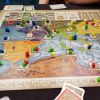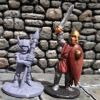Fringe Review: Superhero:44 from ZDL's blog
This is not that game. Or, rather, it is that game. It is that game as it existed before Lou Zocchi published it under the Gamescience umbrella. Published under the subtitle "THE CAMPAIGN OF SUPERPOWERED CRIMEFIGHTERS IN THE YEAR 2044" in 1977, it's an odd duck of a game that's somewhere between a skirmish level wargame and a role-playing game.
It's from humble seeds like these that the hobby grew into what it is nowadays.
Origin Story
Donald Saxman played in a "medieval fantasy campaign" under Mike Ford, an apparently very creative gamer who would have assault guns as often as dragons in his fantasy games, not to mention "over two dozen alternate universes, each with its own natural laws and historical motif". One of those alternate worlds was a world populated by comic and pulp novel heroes. Rules for this latter one were a pastiche of rules adapted willy-nilly from other games since at the time there were no rules specifically for that genre. Saxman, inspired by Ford's campaign, embarked upon a course of making his own set of rules for the superhero genre.
The Book
Superhero:44 is a self-published 48-page booklet printed on plain white paper with a pale brown cover made of light, matte card stock. It is so much a DIY labour of love it hurts: the text is obviously typewritten and pasted into place for reproduction. The art—which is surprisingly good for the era and budget!—is all black-and-white line art which ranges from barely-better-than-doodling to quite impressive set pieces, with more toward the latter. (About one page in three has some kind of art on it.) One nice touch is that each artist is individually credited for each work on each page.
Reproduction of the text is imperfect (to put it politely) and can be a bit of a strain to decode. (The later, expanded, Gamescience publication of this game as Superhero:2044 is much easier to read despite being in smaller text.)
There is a one-page foreword, sixteen pages of background, eight pages of "player setup" rules (character generation and coverage of character planning), six pages of combat rules, eleven pages of "handicapping and patrol" rules (for which q.v.) and four pages of costs and salaries.
The Rules
Being, as it is, a game made by early gamers who still hadn't quite sussed that role-playing games and wargames are different breeds of games, this game has many of the flaws of early games (like the original Dungeons & Dragons, as a matter of fact). Concepts are introduced in an order that seems a little quirky to people who are used to modern game writing, and there is a focus on things which have been deprecated or fallen entirely by the wayside in modern games.
That being said, it also has quite a few innovations which people today might find surprising coming out in 1977. This is, after all, a year before which there were only three published RPGs: Dungeons & Dragons, Metamorphosis Alpha, and Empire of the Petal Throne. In this year Chivalry & Sorcery was first published, as was Traveller. This is when the first book for Advanced Dungeons & Dragons was published, as was the original "blue box" of Dungeons & Dragons. This game predates Runequest and Gamma World! (Which is to say that there is a reason why this game has some oddities when viewed by the modern reader.)
So lets dive in and look at both the innovations and oddities, shall we?
Background
While not really counting as an innovation at this point, it is still unusual that Superhero:44 has a (for the time) detailed setting. Before this only Metamorphosis Alpha had a (very sketchy) setting, and Empire of the Petal Throne had a(n extensive) setting. Many games published after this one, well into the 1980s, had no setting provided, or one that was so sketchy (like Metamorphosis Alpha's) that it made little difference.
The setting for Superhero:44 is Earth in the year (unsurprisingly) 2044 in the fictitious city of Inguria, "the city of the future". This setting is intentionally kept small as an introductory set from which borders a campaign can spring out into a broader world as desired. To cite the author's intent:
Superhero '44 can be played on many levels. The handicapping scenarios can be enjoyed as short games in themselves. With the use of weekly planning sheets and patrol result calculation Superhero ' 44 can be maintained as a campaign over a long period of time. It is also possible to use the combat system to play specially designed scenarios, commando raids, or situations actually taken from comics or novels. In the ultimate form it can be successfully combined with other similar games and inject novelty into other campaigns.
The island (Shanter Island) holding Inguria is located in the west Pacific in the area of Korea. It's "future" history includes an Indian-Australian war and a six-day war in 2006 that's strongly hinted at being nuclear in nature. In 2032 first contact with aliens from "Formalhaut" ...
You know what? This is too much information to pack into a review. Basically Inguria became the centre of "Formian" presence on Earth and also a hub of "uniques" and other crime-fighting (and criminal) types' activities. In a few short pages the background covers history, technology, psychology, economics, politics (both earthly and with the aliens), and geography. It's very densely packed with overview information: quite a shock for a game self-published in 1977!
Player Setup
Characters in Superhero:44 are defined by seven "prime requisites": Vigor, Stamina, Endurance, Mentality, Charisma, Ego, and Dexterity. As a capsual summary, Vigor measures health; Stamina measures ... a lot: "offensive and defensive hand-to-hand righting ability, as well as the ability to run fast, hold one's breath, etc."; Endurance measures resistance to injury from various sources; Mentality covers intelligence and education; Charisma covers looks and strength of personality; Ego is the mental version of Endurance; Dexterity covers speed, reaction time, balance, hand-eye coordination, etc.
Huh. No measurement for strength. What an odd oversight. It probably shows up in the powers or such, right? (Foreshadowing: nope.)
Further, characters are members of one of three groups: Uniques (think Superman or the X-men), Toolmasters (think Batman or Iron Man), and Ubermensch (think Tarzan or, if you squint right, maybe Captain America).
To make a character, first a background has to be written up (!), and a character type selected. Then the prime requisites are done up. By point assignment.
This is, to my knowledge, the very first published RPG with a purely point-assigned character generation system.
There are three steps in assigning points.
1. Each character gets 140 points to distribute over the 7 prime requisites. Each prime requisite must have at least 1 point after all the steps are gone through, but there is no upper limit.
2. Each character type gets modifications to prime requisites. Uniques get +20 Charisma, for example, while an Ubermensch gets +20 to Endurance, Vigor, Stamina, and Dexterity, but -20 to Mentality.
3. At the discretion of the referee, a single, very specific +50 bonus can be given in a limited area. For example a character may be given a +50 bonus to Vigor, but only vs. firearms.
And here, too, not only do we have the innovation of a point-assigned character generation. We have the vestigial beginnings of full-blown advantage and disadvantage systems:
Some powers do not adapt well to this system, and alternate ways of representing abilities are certainly allowed if they can be quantified in some manner and do not unbalance the game. Plus and minus additions on attacks may be given. Characters who accept weaknesses or disabilities (kryptonite, for instance) should be rewarded with extra power.
This is in 1977!
In case this onerous task of coming up with a background and 7 numbers is too much for the player to comprehend, the book helpfully provides three sample characters, one of each type.
Then it ... goes a little weird. It goes straight into the "weekly planning sheet". No introduction of the concept. There's no game system talk yet aside from some tables showing the effect of (some!) prime requisites at various levels. It just jumps from character generation (and prime requisite levels) into:
Each week each character must submit a planning sheet to the referee. This sheet should tell the status of a hero at the beginning of the week. The referee uses this information to calculate how many and what kind of crimes are encountered during the week. He determines the result of each encounter, totals the rewards and bonuses, and notes any lawsuits, injuries, or captures before returning the sheet to the player.
And in the introduction the writer posits this as the default play, recall. The planning sheet (which also doubles as a character sheet) is literally a schedule of when the character works, goes on patrol, changes in pecuniary circumstances, health issues, crime stats and ... well ... everything that in a more modern game would be played out live, not once a week by paperwork. Very odd.
Then, finally, it gets to what we would consider the main body of rules (and entire point of the game!) these days.
Combat
OK, I'm being a little bit sarcastic. Obviously the point of RPGs isn't just combat. It is telling, however, that in most RPGs the rules for combat are long and detailed and the rules for social interactions or other non-combat forms of conflict are sketchy (if present at all) and vague.
This game doesn't have that problem. It has no rules for anything that's not combat, really. Combat is detailed and everything else is basically non-existent except in passing, like a drive-by shooting of rules only using whiffle balls instead of bullets.
So let's deal with what's actually in the rules before we look at what's not there except in very brief passing.
Combat is divided into turns. Each turn has one round for each player or group. In each round, a player (or group) may move twice, attack twice, or move once, then attack once. (Never attack once, then move once.) Attacks are one of four kinds: direct physical attack, transformation (?), mental attack, or projectile attack. Mental and physical attacks are resolved using a universal combat matrix where a 3d6 roll must exceed or equal a target number, but transformation attacks are resolved using their own procedure on their own table.
The rules on initiative and ordering are confusing and contradictory. Each turn has a round for each player or group. Movement is simultaneous, but people with higher dexterity go first. And then the sudden introduction of "phases" in the middle of a sentence changes the nature of the system entirely. Damage is supposed to be applied at the end of all players' rounds, but the phases are such that someone is guaranteed at least one move before they're injured. Despite damage applying at the end of all rounds.
The rules are not clear and not well thought-out, I'm trying to say. (And I haven't even yet addressed the way powers are addressed or—foreshadowing!—aren't...)
Intermission: The full combat sequence is documented (for want of a better term) in a half page of badly-written and inconsistent rules plus a small handful of simple tables. The total rules for this section (including damage, healing, and movement) amount to six pages, equally lacking in rigour. This is very much a disease of old school rules, traditional dating back to the original 1974 Dungeons & Dragons rules. As with that venerable rules set, instead of offering the oft-derided "rules for everything" it offers "rules for almost nothing, but what it does supply rules for is inconsistent and baffling".
Physical damage is done to vigor, to endurance, or to both. Losing vigor represents actual injury while losing endurance represents pain and shock. Different classes of attacks have different mixes of vigor or endurance loss and offer different modifications to stamina for the attack chart. Projectile damage has the added minor complexity of dealing with locations hit.
Mental attacks don't do damage: they're instead illusions, mind control, etc. and once successful just continue being successful until circumstances change.
Transformation attacks are a catch-all category that includes actual transformation (like into stone, say), making lighter, heavier, or phased out or such. (There is no real guidance given as to what that entails.)
Movement is dirt simple: you have a number of "inches" you can move per phase. An inch is either 2 metres (10 second turns, the usual), or 500m (30 second turns, larger scale). Your movement comes from a combination of your stamina, your species (if applicable), and any tools you may use to perform movement.
Oversights
While we should cut the game some slack, seeing as it is the first game of its kind ever, it needs to be pointed out how little this game actually provides in its rules. I mentioned earlier that we saw vestigial advantages and disadvantages, but I glossed over just how vestigial, reserving this for when the rules got introduced.
There are no powers listed. At all. Any references to powers are mentioned only in passing. They're mentioned, for example, in the sample characters:
Apollyon is a master of disguise and of computers. (His 50-point bonuses are gained in these areas.) His favorite disguise is that of some master criminal he has recently thrown into the power screens. (This MO raises his To Locate handicap somewhat and helps to balance out his high Prevention score.)
West has developed a weapon that disrupts matter and can be set to stun or completely disintegrate . It almost al ways works, so he is sued only aoout once a week.
Charmer uses her fifty charisma points as a mental attack and can force humans (only) to follow her vocal commands. Obedience is always literal and immediate. She uses this power to get money to hire investigators.
They're mentioned in passing in some rules:
Certain special powers may alter the sequence of combat. For instance, Super-speed will allow multiple attacks in one round. Some projectile weapons are capable of more than one shot per round. Players with high dexterity may be able to attack in more than one manner in a single round. Some kinds of attack require more than one turn to take effect.
This is an attempt to change the defender into some different object through magic, supertechnology or some unique power. Transformation may be to stone, ice, an animal, or may mean "phasing out ." It also may include making heavier, lighter, etc.
There is nothing systematic in coverage of these. There's not even any words of guidance for how to assess impact and balance of these. It's almost all Referee fiat (which is another disease of the old school gaming world).
And I can't really cut the game slack for this since there have been better rules written before this set. Yes, RPGs as a concept were new. Game rules, however, are game rules. We've done better before this one by over a century.
Handicapping & Patrol
This forms the bulk of the actual rules of the game, and it is very telling what that signifies. The default mode of play is something more reminiscent of GDW's 1975 proto-RPG En Garde. In the handicapping and patrol system, the handicap is a score from "10 to 80" formed by adding together eight values ranked from 1 to 10. (I'm seeing math problems here...)
The scores are in prevent, locate, stop, capture, convict, leads, damage, injured/captured. Prevent is a measure of the character's patrols preventing crime from taking place at all, locate is a measure of finding crimes, capture is a measure of capturing criminals, damage is the tendency to cause collateral damage, etc.
These scores are used to design handicapping scenarios in which all eight areas are to be "tested".
Note, that this is the very first mention of handicapping scenarios and it offers no definition of what that is. It's an adventure. Probably. How do we know? There's an example of one and by inference...
"By inference" is a lousy way to deliver rules, in my opinion. This is, again, a disease of the old school game seen time and again in the era.
Handicapping scenarios, however, are only the lead-in to patrols, which is a paperwork-intensive system (the paperwork having already been introduced, recall) in which the handicapping scenario is used to set the flavour of overall patrolling based on the handicaps the scenario set to determine the outcome of the character's patrolling. The recommended rate is one weeks' worth of patrolling calculations per one week real play time. The outcomes of this system include monetary expenditures and income, injuries sustained, lawsuits, etc. In brief what would be the goal of actual RP in modern designs is relegated to a few dice rolls and calculations in the background, rather like En Garde's campaign system.
Unlike the slipshod, inconsistent, incomplete combat and "handicapping scenario" rules, however, I cut the patrol system some slack. This is an early RPG and was written at a time when RPGs were still largely considered a branch of miniatures wargaming. The systems provided are not to my taste (and likely not to the taste of many modern RPG players), but they are well-written, well-communicated, and do what they were intended to do.
Costs & Salaries
The rules close off with the traditional-for-the-times obsession with equipment lists and monetary costs. Some of this builds up on the patrol system (salary, litigation, etc.) and some of it is just said lists. It's a mercifully short section with simple, comprehensible rules.
Final Thoughts
And this brings us to the important part of the review: the one that answers the Three Questions:
1. What was the author trying to accomplish?
2. Did the author accomplish this?
3. Was it worth accomplishing?
The author was trying to write a set of rules for a specific style of half-skirmish level miniatures, half-old-timey RPG game that covered a genre that had not yet been covered. And in this, once you filter for the times (where the entire notion of an RPG hadn't yet solidified!), he was largely successful.
It was not an unmitigated success, however.
While many of the "flaws" of the game can be accounted for by virtue of time-and-place filters, the complete lack of any kind of sensible guidance for superpowers in a game of superheroes is largely inexcusable. I'm not looking for Champions-esque hyper-detailed book-keeping (oh GOD no!), but it would not be out of place, in a game about superheroes with superpowers, to have a few pages devoted to discussions about superpowers and how they might impact game play.
And then there's the bizarre omissions! They name-drop Superman ... but the rules don't have anything related to strength. Even back in 1977 the notion of "strength" wasn't an unusual one. The three prior-published games had the notion and the game published the same year (Chivalry & Sorcery) also did. How did the author overlook this?
And the fact that the rule are internally inconsistent or outright wrong (1×8=8, not 10!) in many places is also a pretty big red flag.
So was it worth the effort?
Superhero:44 has an important place in the history of RPGs, being first in an important genre, but its place is marred by the poor delivery of the rules and a design decision that put it out of the path of where the hobby eventually grew. In my opinion the first really usable superhero role-playing game was 1980s Supergame. (I'll bet you thought I was going to say Champions!)
















The Wall